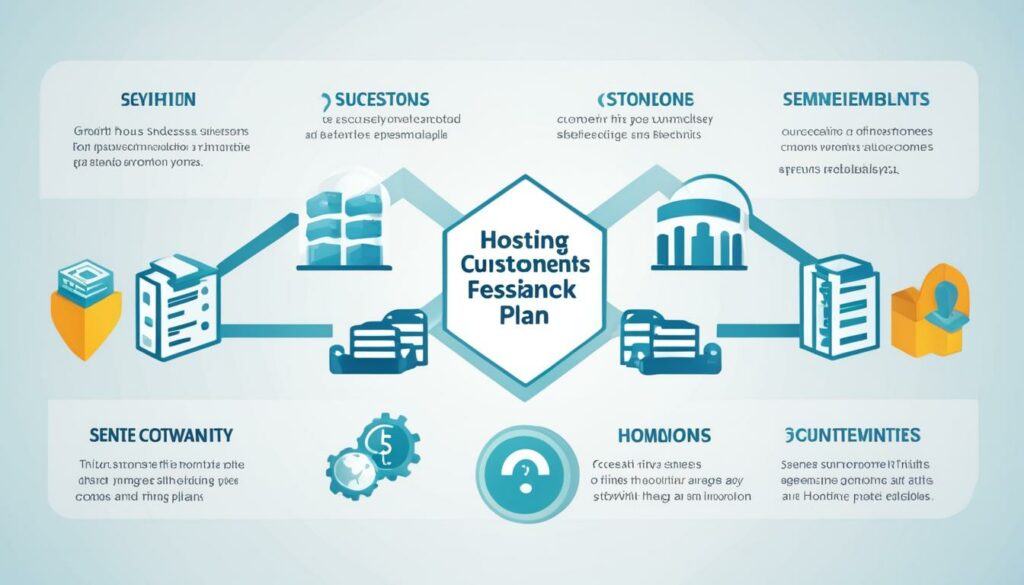Welcome to our article on host reliability testing. If you own a website or manage a server, you know how crucial it is to ensure its optimal performance and uptime. This is where host reliability testing comes into play. By conducting comprehensive tests before your system goes live, you can identify and address potential issues or vulnerabilities. In this article, we will provide you with key insights and best practices for conducting host reliability testing.
Key Takeaways:
- Host reliability testing is essential for website and server performance and uptime.
- It helps identify and address potential issues or vulnerabilities before going live.
- Scalability, redundancy, resilience to network outages, and latency tolerance are important factors in host reliability testing.
- Using testing methodologies like Gremlin can help ensure system reliability.
- Not conducting host reliability testing can result in scaling issues, service failures, dependency problems, and latency issues.
Why is Host Reliability Testing Important?
Host reliability testing plays a crucial role in ensuring the system reliability of your website or server. By conducting comprehensive tests before production, you can proactively identify and address any potential reliability issues or vulnerabilities, resulting in a more dependable and efficient system.
When it comes to hosting, scalability, redundancy, resilience, and latency tolerance are essential factors that need to be thoroughly tested. Scalability testing ensures that your system can handle increasing demands and traffic without compromising performance. Redundancy testing verifies the availability of backup systems or components, preventing single points of failure and minimizing service disruptions.
Resilience testing evaluates your system’s ability to withstand network outages, ensuring seamless operation even during unforeseen events. Finally, latency tolerance testing guarantees that your system can deliver optimal performance and responsiveness, even under challenging network conditions.
Host reliability testing is the foundation for a solid and dependable system, giving you the confidence that your website or server will be reliable, stable, and perform optimally under various circumstances.
By conducting host reliability testing, you can avoid potential system failures, minimize downtime, and significantly improve the user experience. It allows you to proactively address any issues before they affect your users, ensuring a smooth and consistent service. Investing time and effort into host reliability testing ultimately leads to a more robust and trustworthy system that you can rely on.
Key Benefits of Host Reliability Testing:
- Enhanced system reliability and uptime
- Improved user experience and satisfaction
- Minimized downtime and service disruptions
- Early identification and mitigation of potential issues
- Optimized system performance under demanding conditions
Host reliability testing is an essential step in the development and maintenance of a reliable and efficient hosting environment. It ensures that your system is adequately prepared to handle real-world scenarios and deliver a seamless experience to your users.
| Key Aspects of Host Reliability Testing | Description |
|---|---|
| Scalability | Testing the ability of your system to handle increasing demands and traffic without performance degradation. |
| Redundancy | Verifying the availability of backup systems or components to prevent single points of failure. |
| Resilience | Evaluating the ability of your system to withstand network outages and maintain seamless operation. |
| Latency Tolerance | Testing the responsiveness and performance of your system under challenging network conditions. |
Ensuring the reliability of your hosting environment is crucial for maintaining a successful online presence. Host reliability testing empowers you to uncover and fix potential issues or vulnerabilities, safeguarding the stability and performance of your system. By investing in comprehensive testing and adhering to best practices, you can create a hosting environment that consistently delivers an outstanding user experience.
Best Practices for Host Reliability Testing
When it comes to host reliability testing, following best practices is crucial. These practices ensure that you conduct comprehensive and effective tests to identify any potential issues or vulnerabilities in your system. Here are some best practices to keep in mind:
1. System Testing
Perform thorough system testing to evaluate the overall reliability and stability of your host. This includes testing various components and functionalities of your system to ensure they function as intended.
2. Scalability Testing
Test the scalability of your host by simulating increased user traffic and workload. This helps you determine whether your host can handle high volumes of traffic without experiencing performance degradation or downtime.
3. Redundancy Testing
Validate the redundancy measures in place to ensure continuous service availability. Test your system’s ability to recover from failures, such as hardware or software failures, and verify that redundant components function as expected.
4. Network Performance Testing
Evaluate the performance of your host’s network infrastructure to ensure optimal communication and data transfer between different components. This includes testing network latency, bandwidth, and packet loss to identify any potential bottlenecks or performance issues.
5. Latency Testing
Assess the responsiveness of your host by measuring latency. Latency testing helps you determine the time it takes for your host to respond to user requests, ensuring a smooth and responsive user experience.
“Conducting thorough host reliability testing is essential to ensure the stability and performance of your system. By following these best practices, you can mitigate potential risks, improve system reliability, and enhance user satisfaction.”

By implementing these best practices for host reliability testing, you can proactively identify and address any issues or vulnerabilities in your system. This ensures that your host remains reliable and performs optimally, providing a seamless experience for your users.
Testing Methodologies for Host Reliability
When it comes to ensuring the reliability of your hosts, there are various testing methodologies at your disposal. One popular and effective approach is utilizing pre-built reliability tests offered by Gremlin. These tests are specifically designed to validate the resilience of your system against common failure modes, enabling you to meet the best practices for reliability.
Giving you peace of mind, Gremlin’s reliability tests cover multiple categories crucial for host reliability testing, including scalability, redundancy, and resilience to network outages. By leveraging these testing methodologies, you can effectively assess and address potential issues or vulnerabilities within your system.
The Gremlin Advantage
“Gremlin’s reliability tests allow you to proactively test your system and identify weaknesses before they turn into costly failures for your business.”
By incorporating Gremlin’s testing methodologies into your host reliability testing strategy, you gain a comprehensive understanding of your system’s capabilities and its resilience in the face of adversity. The insights derived from these tests equip you with the knowledge needed to optimize your system’s performance and minimize the risk of unexpected failures.
Ensuring Resilience Across Distributed Systems
Reliability tests are particularly crucial when it comes to distributed systems, as failures can have far-reaching consequences. Gremlin’s reliability tests provide invaluable insights into the failure modes specific to distributed systems, enabling you to identify and address potential weaknesses in your setup.
With Gremlin, you can tailor your reliability tests to simulate a wide range of failure scenarios, ensuring that your system can handle real-world situations with ease. Whether it’s network partitions, latency issues, or unexpected hardware failures, Gremlin’s testing methodologies are designed to address these failure modes head-on.
Extracting Crucial Insights from Host Reliability Testing
Host reliability testing is not just about validating the reliability of your system; it’s about gaining actionable insights that drive meaningful improvements. By conducting thorough and comprehensive reliability tests, you extract crucial insights into the resilience of your hosts, helping you fine-tune your system’s performance and minimize downtimes.
During the testing process, it’s important to track and analyze key metrics related to scalability, redundancy, and resilience. These metrics provide you with valuable data to identify areas of improvement and make informed decisions about optimizing your system’s reliability.
| Category | Key Metrics |
|---|---|
| Scalability | Response time under increasing load, system capacity |
| Redundancy | Failover time, data replication efficiency |
| Resilience to Network Outages | Recovery time from network failures, impact on overall system performance |
Visualizing the Results
Visualizing the results of your host reliability testing can provide clear insights into the strengths and weaknesses of your system. By leveraging data visualization tools, you can easily identify patterns, trends, and outliers that may require further investigation or optimization.

By visually representing the results of your reliability tests, you can effectively communicate the impact of potential failure modes and showcase the measurable improvements resulting from your testing efforts.
The Impacts of Not Conducting Host Reliability Testing
Not conducting host reliability testing can have significant impacts on your system. Without proper testing, you may experience several issues that can compromise the performance and stability of your website or server.
Scaling issues: One of the main impacts of not conducting host reliability testing is scalability issues. When your system is unable to handle increasing demand, it may result in downtime or crashes. This can lead to a poor user experience, loss of customers, and damage to your reputation.
Service failure: Without proper redundancy in place, service failures can occur. If a critical service goes down, and there is no backup or failover mechanism, it can disrupt the entire system. This can lead to prolonged downtimes and significant disruption to your business operations.
Dependency problems: The lack of resilience to slow or failed dependencies can create dependency problems. Your system may rely on external services or APIs, and if those dependencies fail, it can impact the functionality of your own system. This can result in errors, slower performance, and ultimately a negative user experience.
Latency issues: Not conducting host reliability testing can leave you vulnerable to latency issues. Latency refers to the delay or lag in response times. If your system is not adequately tested for latency, it can cause a slow or sluggish user experience, frustrating your users and driving them away from your website or application.
Table: Impacts of Not Conducting Host Reliability Testing
| Impacts | Description |
|---|---|
| Scaling Issues | System unable to handle increasing demand, leading to downtime and crashes |
| Service Failure | Lack of redundancy causes complete service failures and prolonged downtime |
| Dependency Problems | Lack of resilience to slow or failed dependencies disrupts system functionality |
| Latency Issues | Slow or sluggish user experience due to inadequate testing for latency |
By not conducting host reliability testing, you risk encountering these issues and negatively impacting your users’ experience. It is crucial to prioritize host reliability testing to ensure the optimal performance, stability, and user satisfaction of your website or server.

Conclusion
Host reliability testing plays a crucial role in ensuring the optimal performance and uptime of your website or server. By implementing best practices and conducting comprehensive testing for scalability, redundancy, resilience, and latency tolerance, you can identify and address any potential issues or vulnerabilities in your system. This not only improves the reliability of your system but also enhances the overall user experience, resulting in increased customer satisfaction.
By prioritizing host reliability testing, you proactively ensure that your system remains stable and performs well under a variety of conditions. This not only minimizes the risk of downtime and service failures but also prepares your system for scalability, ensuring it can handle increasing demand as your business grows. With a reliable system, you provide your users with consistent performance, increased uptime, and a seamless browsing experience.
Investing in host reliability testing also helps you optimize system performance. By conducting thorough tests, you can identify bottlenecks, optimize resource allocation, and fine-tune your system for better efficiency. This ultimately leads to faster response times, improved load balancing, and a more responsive user interface, contributing to a positive user experience.
FAQ
Q: What is host reliability testing?
A: Host reliability testing is the process of conducting tests to validate the reliability of a website or server system before it goes into production. It involves testing for scalability, redundancy, resilience to network outages, and the ability to tolerate latency.
Q: Why is host reliability testing important?
A: Host reliability testing is important because it allows you to identify and address any reliability issues or vulnerabilities in your system before it goes into production. By conducting tests specifically designed to validate a system’s reliability, you can ensure that it will remain available and perform well under less than ideal conditions.
Q: What are the best practices for host reliability testing?
A: Best practices for host reliability testing include testing for scalability, redundancy, resilience to network outages, and the ability to tolerate latency. It is crucial to simulate real-world scenarios and ensure that your system can handle increasing demand, recover from failures, and maintain optimal performance even with slow or failed dependencies.
Q: What testing methodologies can be used for host reliability testing?
A: One popular approach is to use pre-built reliability tests, such as those provided by Gremlin. These tests are designed to validate resilience against common failure modes and ensure that your services meet best practices for reliability. They cover various categories, including scalability, redundancy, and resilience to network outages.
Q: What are the impacts of not conducting host reliability testing?
A: Not conducting host reliability testing can result in scaling issues, service failures, dependency problems, and latency issues. Without proper testing, your system may not be able to handle increasing demand, recover from failures, or maintain optimal performance. This can negatively impact the user experience and lead to downtime, crashes, or slow response times.
Q: How can host reliability testing improve system performance and uptime?
A: Host reliability testing ensures that your system has been thoroughly tested for scalability, redundancy, resilience, and latency tolerance. By addressing any potential issues or vulnerabilities before production, you can improve the reliability of your system and enhance the overall user experience. This will help your system remain stable and perform well under a variety of conditions.












